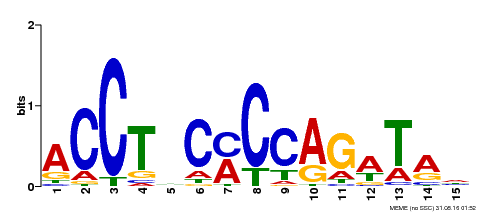 |
PlantRegMap/PlantTFDB v5.0
Plant Transcription
Factor Database
|
| Home TFext BLAST Prediction Download Help About Links PlantRegMap |
Transcription Factor Information
| Basic Information? help Back to Top | |||||||||
|---|---|---|---|---|---|---|---|---|---|
| TF ID | Thecc1EG036719t1 | ||||||||
| Common Name | TCM_036719 | ||||||||
| Organism | |||||||||
| Taxonomic ID | |||||||||
| Taxonomic Lineage |
cellular organisms; Eukaryota; Viridiplantae; Streptophyta; Streptophytina; Embryophyta; Tracheophyta; Euphyllophyta; Spermatophyta; Magnoliophyta; Mesangiospermae; eudicotyledons; Gunneridae; Pentapetalae; rosids; malvids; Malvales; Malvaceae; Byttnerioideae; Theobroma
|
||||||||
| Family | C2H2 | ||||||||
| Protein Properties | Length: 509aa MW: 56197.7 Da PI: 6.7856 | ||||||||
| Description | C2H2 family protein | ||||||||
| Gene Model |
|
||||||||
| Signature Domain? help Back to Top | |||||||
|---|---|---|---|---|---|---|---|
| No. | Domain | Score | E-value | Start | End | HMM Start | HMM End |
| 1 | zf-C2H2 | 21.1 | 8.5e-07 | 262 | 283 | 2 | 23 |
EETTTTEEESSHHHHHHHHHHT CS
zf-C2H2 2 kCpdCgksFsrksnLkrHirtH 23
C++Cgk F+r nL+ H+r H
Thecc1EG036719t1 262 FCTICGKGFKRDANLRMHMRGH 283
6*******************98 PP
| |||||||
| Protein Features ? help Back to Top | ||||||
|---|---|---|---|---|---|---|
| Database | Entry ID | E-value | Start | End | InterPro ID | Description |
| SuperFamily | SSF57667 | 2.25E-5 | 259 | 286 | No hit | No description |
| PROSITE profile | PS50157 | 12.03 | 261 | 288 | IPR007087 | Zinc finger, C2H2 |
| SMART | SM00355 | 0.0026 | 261 | 283 | IPR015880 | Zinc finger, C2H2-like |
| Pfam | PF12874 | 0.001 | 262 | 283 | No hit | No description |
| Gene3D | G3DSA:3.30.160.60 | 7.5E-6 | 262 | 312 | IPR013087 | Zinc finger C2H2-type/integrase DNA-binding domain |
| PROSITE pattern | PS00028 | 0 | 263 | 283 | IPR007087 | Zinc finger, C2H2 |
| SMART | SM00355 | 53 | 310 | 343 | IPR015880 | Zinc finger, C2H2-like |
| SMART | SM00355 | 22 | 348 | 370 | IPR015880 | Zinc finger, C2H2-like |
| Gene Ontology ? help Back to Top | ||||||
|---|---|---|---|---|---|---|
| GO Term | GO Category | GO Description | ||||
| GO:0006355 | Biological Process | regulation of transcription, DNA-templated | ||||
| GO:0010044 | Biological Process | response to aluminum ion | ||||
| GO:0010447 | Biological Process | response to acidic pH | ||||
| GO:0005634 | Cellular Component | nucleus | ||||
| GO:0003676 | Molecular Function | nucleic acid binding | ||||
| GO:0003700 | Molecular Function | transcription factor activity, sequence-specific DNA binding | ||||
| GO:0046872 | Molecular Function | metal ion binding | ||||
| Sequence ? help Back to Top |
|---|
| Protein Sequence Length: 509 aa Download sequence Send to blast |
MDLKERLSGE LQKKVPEHPS FTNFNTQHQQ KWEDPSILDY STRIEPPFHV FNQTSQTQSS 60 LPRNPNNQIK VLGQDGPVNE TLLANKVQDW DPSAMLNNLS FLEQKIHQLQ ELVHLIVGRR 120 GQVLGRPDEL VAQQQQLITA DLTSIIVQLI STAGSLLPSV KHTLSAASPS IGQFGQFGGV 180 VFPSGQGLNG GVQPQSAGGS RISEQPNSVD VSSNSGNEQN HIIEEHELKD EEDVEEGENL 240 LPGTYEILQL EKEEILAPHT HFCTICGKGF KRDANLRMHM RGHGDEYKTP AALAKPNKES 300 SSEPTLIKRY SCPYAGCKRN KDHKKFQPLK TILCVKNHYK RTHCDKSYTC SRCNTKKFSV 360 IADLKTHEKH CGKDKWLCSC GTTFSRKDKL FGHITLFQGH TPAIPLDENK GSAGPSDHRG 420 DGNQATNKVG SMNFNFSSNV SSEGGVQSSV DVKGSIDDPA GYFSPLNFDT CNFGGFHEFP 480 RPPFDDSENS FAFLLSGSCN YSQKSGED* |
| Functional Description ? help Back to Top | ||||||
|---|---|---|---|---|---|---|
| Source | Description | |||||
| UniProt | Probable transcription factor. Together with STOP2, plays a critical role in tolerance to major stress factors in acid soils such as proton H(+) and aluminum ion Al(3+). Required for the expression of genes in response to acidic stress (e.g. ALMT1 and MATE), and Al-activated citrate exudation. {ECO:0000269|PubMed:17535918, ECO:0000269|PubMed:18826429, ECO:0000269|PubMed:19321711, ECO:0000269|PubMed:23935008}. | |||||
| Binding Motif ? help Back to Top | |||
|---|---|---|---|
| Motif ID | Method | Source | Motif file |
| MP00196 | ampDAP | Transfer from AT1G34370 | Download |

| |||
| Regulation -- Description ? help Back to Top | ||||||
|---|---|---|---|---|---|---|
| Source | Description | |||||
| UniProt | INDUCTION: By shock H(+) and Al(3+) treatments. {ECO:0000269|PubMed:17535918}. | |||||
| Regulation -- PlantRegMap ? help Back to Top | ||||||
|---|---|---|---|---|---|---|
| Source | Upstream Regulator | Target Gene | ||||
| PlantRegMap | Retrieve | Retrieve | ||||
| Annotation -- Protein ? help Back to Top | |||||||
|---|---|---|---|---|---|---|---|
| Source | Hit ID | E-value | Description | ||||
| Refseq | XP_007020278.1 | 0.0 | PREDICTED: protein SENSITIVE TO PROTON RHIZOTOXICITY 1 | ||||
| Swissprot | Q9C8N5 | 0.0 | STOP1_ARATH; Protein SENSITIVE TO PROTON RHIZOTOXICITY 1 | ||||
| TrEMBL | A0A061FKR4 | 0.0 | A0A061FKR4_THECC; C2H2 and C2HC zinc fingers superfamily protein | ||||
| STRING | EOY17503 | 0.0 | (Theobroma cacao) | ||||
| Orthologous Group ? help Back to Top | |||
|---|---|---|---|
| Lineage | Orthologous Group ID | Taxa Number | Gene Number |
| Malvids | OGEM6977 | 26 | 44 |
| Best hit in Arabidopsis thaliana ? help Back to Top | ||||||
|---|---|---|---|---|---|---|
| Hit ID | E-value | Description | ||||
| AT1G34370.2 | 0.0 | C2H2 family protein | ||||
| Link Out ? help Back to Top | |
|---|---|
| Phytozome | Thecc1EG036719t1 |
| Entrez Gene | 18593149 |



